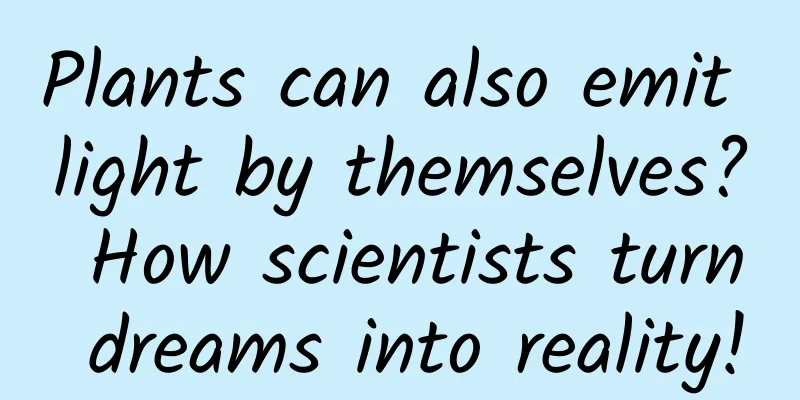Plants can also emit light by themselves? How scientists turn dreams into reality!

|
You wake up from your sleep and find that everything is covered by a dreamy blue light. All kinds of strange creatures grow around you. Huge glowing trees tower into the sky, and the leaves on the trees sparkle like gems. Under the trees, patches of glowing grass sway gently like a green ocean. The flowers here exude a charming fragrance, and the petals shine with colorful light in the night. Even at night, the whole world is like a bright starry sky, shining. Plants glow? This distant and incredible dream has been gradually turned into reality by scientists in recent years. In nature, bioluminescence often occurs in fungi, bacteria, insects and other organisms, but little is known about bioluminescence in plants. However, with the continuous development of synthetic biology, scientists have successfully created a new type of luminescent plant inspired by the luminescence mechanism of fungi. I will take you into this magical self-luminous plant and explore its principles, application prospects, and its implications for high-quality development in agriculture, energy, environment and other fields. Principle of FBP reporter system for luminescent plants Bioluminescence refers to a series of chemical reactions that occur in organisms to produce visible light. It is currently believed that there are at least 40 different bioluminescent systems in nature, but due to the limitations of research technology, only two systems have been fully understood, namely the bacterial luminescent system (1980s) and the fungal luminescent system (2018). This article focuses on the fungal bioluminescence pathway FBP (Fungal bioluminescence pathway), which exists in some luminous fungi in nature and can produce green bioluminescence with a wavelength of about 520nm under suitable conditions. This pathway is a caffeic acid metabolic cycle composed of four enzymes, namely, caffeic acid is converted into galactin by the action of hispidin synthase (HispS), which is then catalyzed by hispidin-3-hydroxylase (H3H) to produce fungal luciferin, which is oxidized into caffeoylpyruvate and produces photons by the action of fungal luciferase (Luz), and finally caffeoylpyruvate hydrolase (CPH) converts caffeoylpyruvate into caffeic acid, thereby producing continuous light visible to the naked eye and realizing the recycling of caffeic acid. Figure 1 Caffeic acid cycle metabolic pathway So, how do scientists introduce this luminescence system of fungi into plants? It turns out that caffeic acid, the starting material of bioluminescence, is a widely existing metabolite of the phenylpropanoid pathway in plants. The researchers integrated the above four genes from luminous fungi into the tobacco genome through Agrobacterium transformation, thereby completing the synthesis of fluorescent proteins in the plant and achieving plant luminescence. The incomparable advantage of the fungal luminescent system is that its raw material, caffeic acid, has extremely low toxicity to animal and plant cells, is highly stable and easily absorbed. Scientists only need to introduce the genes corresponding to the remaining four proteases, regulate the caffeic acid synthesis pathway, utilize the energy distribution regulatory network in the plant, and genetically modify the self-luminous microorganisms to enable plants to have bioluminescence capabilities. The relationship between bioluminescence and photosynthesis Some people may ask, will the self-luminescence of plants consume a lot of energy needed for photosynthesis? If it seriously affects the original photosynthesis of plants, wouldn't it be like picking up sesame seeds and losing watermelons? In fact, there is no need to worry about this. Existing studies have explored the interaction between photosynthesis and plant luminescence metabolism by measuring relevant physiological parameters of photosynthesis, including plant net photosynthetic rate Pn, stomatal conductance Gs, transpiration rate Tr, and quantum efficiency of CO2 assimilation PhiCO2. The results show that the second generation of luminous plants has no negative impact on plant photosynthesis, which indicates that there is still significant potential for improving luminescence intensity in the iterative development of luminous plants in the future. Application prospects of FBP luminescent plants Figure 2 Application of synthetic biology in multiple fields Synthetic biology is currently booming and has shown great application value in various fields. The research and development and upgrading of new plant luminescence systems is no exception. 1. Beautify the environment and low-brightness lighting New varieties of luminous plants can beautify the environment and even create a fantasy world like the one in the movie Avatar. At the same time, they can be used as a substitute for low-brightness lighting to save electricity. In the future, luminous plants can be used in parks, courtyards, homes and other places to achieve green lighting. 2. Bio-new energy industry FBP luminous plants realize the recycling of light energy and bioenergy, without the need for artificial energy supply. This provides a new idea for the development of the bio-new energy industry and is expected to promote changes in the energy field. 3. Biological monitoring and environmental protection FBP luminescent plants can be used as bioluminescent signals to report harmful environmental factors, such as harmful heavy metals and formaldehyde in the soil. By monitoring the changes in luminescent plants, the environmental quality status can be grasped in real time, providing a powerful means for environmental protection. 4. Reporting tools for gene editor effectiveness Since the FBP reporter system of the luminescent plant can emit light visible to the naked eye, it can be used to detect the entire growth period of individual or group organisms through ordinary household cameras. We can use this system as a reporting system to quickly verify the activation effects of different gene editors. By directly observing the luminescence intensity of transgenic plants, the target enzyme content in the plant can be determined, thereby inferring the effectiveness of the new gene editor. This breaks the traditional need for cumbersome molecular determination of plant protein content, and instead only requires the use of a specific camera to measure the size of the light quantum emitted by the plant to determine the target enzyme content in the plant, greatly simplifying the experimental steps and shortening the experimental cycle. Figure 3 Leaf luminescence observed under the 985 system The observations provide strong support for plant synthetic biology. Through methods such as gene editing, metabolic engineering, biomacromolecule dynamic interaction tools and the eFBP (enhanced Fungal bioluminescence pathway) reporting system, plants with special functions can be cultivated faster and more efficiently, contributing to the high-quality development of agriculture, energy, environment and other fields. Enlightenment and Outlook Figure 4 Glowing plants photographed by a normal camera under dark conditions It cannot be ignored that the newly developed second-generation luminous plants are still far from the requirements for practical application. The flowers can only reach 1012photo/min/cm2 photon intensity, and the leaves can only reach 1011photo/min/cm2 photon intensity, which is still not very obvious when observed at night. There is a complex regulatory network in the plant body to coordinate energy distribution, thereby determining the upper limit of bioluminescence. We still need to continuously improve the performance of luminous plants by introducing efficient gene expression tools, and improve the brightness, color, and stability of luminous plants to make them more practical. Using biotechnology and information technology to promote the development of agriculture, energy, environment and other fields is an important way to achieve sustainable development. The research results of FBP reporting system luminous plants have brought unprecedented green technology experience to mankind and provided a useful reference for the integrated development of biotechnology and information technology in my country. I believe that in the near future, this magical new plant will enter our lives and inject strong impetus into high-quality sustainable development. Let us look forward to the Avatar world coming to us. |
>>: Why is the Yellow River named Huang? A brief discussion on the origin of the name "Yellow River"
Recommend
Taklimakan is not a hopeless situation? The birth of desert ninjas!
Few people can live here for long. Even in today&...
Little-known fact: Bamboo is actually a grass? ? ?
The second part of 8 cool facts is here Everyone ...
Iodized salt, non-iodized salt, low-sodium salt...which one is more suitable for your family?
Speaking of salt in supermarkets There are many n...
How was the world's first telegram sent? Uncovering the birth and evolution of the telegram
Throughout human history, the transmission of inf...
Honor X10 review: 35W running points + RYYB night vision lens, redefining the 5G real fragrance phone
Although Honor's X series is not as dazzling ...
Luckin Coffee community operation skills!
After Luckin Coffee was suspended and delisted, i...
Judging from the sales of Double 11, the conclusion that the OTT industry is dying is absurd
In just 38 minutes, Tmall’s total sales reached t...
Could this bowl be a "death bowl"? I didn't expect it to be so harmful! Throw away any bowls at home
Expert of this article: Yang Chao, PhD in Chemist...
3 steps to improve copywriting conversion rate and write popular and well-received copywriting
"100,000+" is a high ground that countl...
Summary of the channel characteristics of advertising on Momo, iQiyi, Kuaishou, etc.!
What are the characteristics of information flow ...
Information flow advertising: Before you fight with the data, think about your purpose
Let me first tell you a real case we received: Xi...
A complete guide to baby food supplements (6 months to 2 years old) 0 to 2 years old is the key period of nutrition, giving your baby the best growth
: : : : : : : : : : : : : : : : : : : : : : : : : ...
Mobile game industry information flow optimization methodology: well-founded material analysis
According to Tencent's Q2 financial report, l...
What are the specific differences between server rental and server hosting?
What is the difference between server rental and ...
LG's poor performance in China may make it the next brand to fall
The industry that is most deeply touched by the p...









